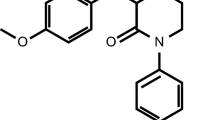Abstract
There is need for a rapid assay to determine the efficacy of low-molecular-weight-heparin (LMWH) in whole blood. Heparinase was used to eliminate, and thereby quantify, the anticoagulant activity of the low-molecular-weight-heparin, enoxaparin. The percent change in the clotting time of whole blood in the presence of heparinase yielded the anticoagulant contribution of enoxaparin. A minimally activated assay (MAA) of whole blood clotting time was evaluated for the detection and relative quantification of enoxaparin. The assay cartridge consisted of a plain glass tube and detection magnet, with no additional sources of activation. Comparisons were also made with a point-of-care, activated partial thromboplastin time (aPTT) assay. Plasma or whole blood was spiked with enoxaparin at concentrations ranging from 0.1 to 1.0 anti-factor Xa IU/ml. A commercial preparation of heparinase I was used to digest enoxaparin, and clotting times were determined with and without heparinase incubation. Heparinase digestion caused an average shortening of clotting time of 21.1% (47.3 s) in blood spiked with 0.4 anti-Xa IU/ml enoxaparin, an amount expected in the therapeutic range; also, 0.1 anti-Xa IU/ml of enoxaparin could be reliably detected. The assay performed comparably when transferred to a point-of-care setting with heparinase being added directly to citrated blood collection tubes, followed by either MAA or aPTT assay. Strong correlations were obtained with both assays between the percent change in clotting time (after heparinase) and the added concentration of enoxaparin, or in comparison with the chromogenically measured concentration of enoxaparin. The assays for an individual blood sample can be completed within 10 min.





Similar content being viewed by others
Notes
Anti-Xa determinations are only routinely available on weekdays at our university hospital. Plasma from blood samples submitted after 9 a.m. is held for assay on the next day.
References
Bates SM, Weitz JI (2005) Coagulation assays. Circulation 112:e53–e60
Gouin-Thibault I, Pautas E, Siguret V (2005) Safety profile of different low-molecular weight heparins used at therapeutic dose. Drug Saf 28:333–349
Bazinet A, Almanric K, Brunet C, Turcotte I, Martineau J, Caron S, Blais N, Lalonde L (2005) Dosage of enoxaparin among obese and renal impairment patients. Thromb Res 116:41–50
El Rouby S, Cohen M, Gonzales A, Hoppensteadt D, Lee T, Zucker ML, Khalid K, LaDuca FM, Fareed J (2006) The use of a HEMOCHRON® JR. HEMONOX™ point of care test in monitoring the anticoagulant effect of enoxaparin during interventional coronary procedures. J Thromb Thrombolysis 21:137–145
Gosselin RC, King JH, Janatpour KA, Dager WE, Larkin EC, Owings JT (2004) Variability of plasma anti-Xa activities with different lots of enoxaparin. Ann Pharmacother 38:563–568
Gogarten W (2006) The influence of new antithrombotic drugs on regional anesthesia. Curr Opin Anaesthesiol 19:545–550
Yang VC, Bernstein H, Cooney CL, Kadam JC, Langer R (1986) Removal of the anticoagulant activities of the low molecular weight heparin fractions and fragments with flavobacterial heparinase. Thromb Res 44:599–610
Maddineni J, Walenga JM, Jeske WP, Hoppensteadt DA, Fareed J, Wahi R, Bick RL (2006) Product individuality of commercially available low-molecular-weight heparins and their generic versions: therapeutic implications. Clin Appl Thromb Hemost 12:267–276
Despotis GJ, Filos KS, Levine V, Alsoufiev A, Spitznagel E (1996) Aprotinin prolongs activated and nonactivated whole blood clotting time and potentiates the effect of heparin in vitro. Anesth Analg 82:1126–1131
Pothula S, Inchiosa MA Jr, Sanchala VT, Sarabu M, Inchiosa AS (2003) In vitro effect of protamine excess on blood coagulation assays. Anesth Analg 96:SCA39. http://www.scahq.org/sca3/events/2003/annual/abstracts/A39.pdf. Accessed 26 August 2010
Inchiosa M Jr, Pothula S, Sanchala V, Kubal K (2006) Detection of low plasma levels of low molecular weight heparin. Anesth Analg 102:SCA10. http://test2.societyhq.com/sca3/events/2006/annual/SCA_2006_Abstracts.pdf#page=16 Accessed 30 August 2010
Sanderink G-JCM, Guimart CG, Ozoux M-L, Jariwala NU, Shukla UA, Boutouyrie BX (2002) Pharmacokinetics and pharmacodynamics of the prophylactic dose of enoxaparin once daily over 4 days in patients with renal impairment. Thromb Res 105:225–231
Zmuda K, Neofotistos D, Ts’ao C (2000) Effects of unfractionated heparin, low-molecular-weight heparin, and heparinoid on thromboelastographic assay of blood coagulation. Am J Clin Pathol 113:725–731
Coppell JA, Thalheimer U, Zambruni A, Triantos CK, Riddell AF, Burroughs AK, Perry DJ (2006) The effects of unfractionated heparin, low molecular weight heparin and danaparoid on the thromboelastogram (TEG): an in vitro comparison of standard and heparinase-modified TEGs with conventional coagulation assays. Blood Coagul Fibrinolysis 17:97–104
Harenberg J (2009) Thrombelastometer and low molecular weight heparin. Anaesthesia 64:920–921
Kozek-Langenecker SA, Mohammad SF, Masaki T, Kamerath C, Cheung AK (2000) The effects of heparin, protamine, and heparinase 1 on platelets in vitro using whole blood flow cytometry. Anesth Analg 90:808–812
Cecchi F, Pacini S, Gulisano M, Macchi C, Catini C, Lova RM, Fuzzi G, Ruggiero M, Vannucchi S (2008) Heparin/heparan sulfate anticoagulant glycosaminoglycans in human plasma of healthy donors: preliminary study on a small group of recruits. Blood Coagul Fibrinolysis 19:349–354
Desjardins L, Bara L, Boutitie F, Samama MM, Cohen AT, Combe S, Janbon C, Leizorovicz A, Olsson C-G, Turpie AGG (2004) Correlation of plasma coagulation parameters with thromboprophylaxis, patient characteristics, and outcome in the MEDENOX study. Arch Pathol Lab Med 128:519–526
Greaves M (2002) Limitations of the laboratory monitoring of heparin therapy. Thromb Haemost 87:163–164
Girolami A, Vettore S (2009) Discrepancies between clotting and chromogenic assays in congenital coagulation disorders: the hemostatic coin has only one face, chromogenic substrates many. Blood Coagul Fibrinolysis 20:484–485
Wijnhoven TJ, van de Westerlo EM, Smits NC, Lensen JF, Rops AL, van der Vlag J, Berden JH, van den Heuvel LP, van Kuppevelt TH (2008) Characterization of anticoagulant heparinoids by immunoprofiling. Glycoconj J 25:177–185
Acknowledgments
Financial support for these investigations was derived solely from departmental and institutional resources. The Hemochron 801 apparatus was provided on loan from the manufacturer, without any consideration or obligation. All assay cartridges were purchased.
Author information
Authors and Affiliations
Corresponding author
Rights and permissions
About this article
Cite this article
Inchiosa, M.A., Pothula, S., Kubal, K. et al. Toward development of a point-of-care assay of enoxaparin anticoagulant activity in whole blood. J Thromb Thrombolysis 32, 47–53 (2011). https://doi.org/10.1007/s11239-010-0546-5
Published:
Issue Date:
DOI: https://doi.org/10.1007/s11239-010-0546-5




